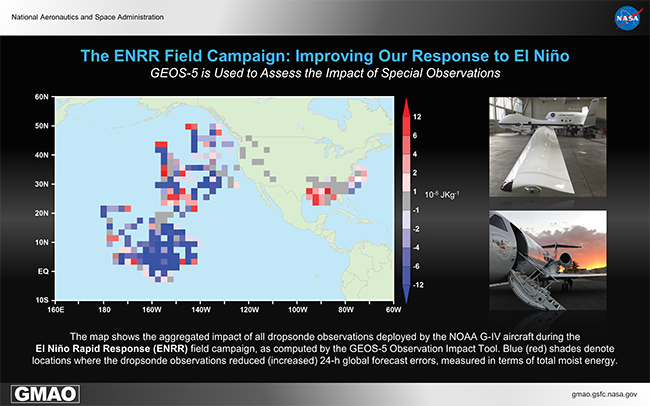The ENRR Field Campaign: Improving Our Response to El Niño
GEOS-5 is Used to Assess the Impact of Special Observations
El Niño is a recurring climate phenomenon characterized by unusually warm ocean temperatures in the equatorial Pacific, which increases the odds for anomalously warm and dry winters across the northern United States and cool, wet winters across the South. The pattern can shift back and forth every two to seven years, disrupting weather patterns across the globe. By standard measures, the 2015-2016 El Niño was one of the strongest on record.
The El Niño Rapid Response (ENRR) field campaign was conducted by the National Oceanic and Atmospheric Administration (NOAA), between January and March of 2016, to determine key mechanisms affecting El Niño's impacts on the U.S. and their implications for improving the Nation's observational systems, models, and forecasts. The ENRR campaign spanned the central and eastern tropical Pacific to California. Multiple types of observing resources collected measurements from the air, ocean, and ground during the course of the campaign, including the NOAA Gulf Stream IV aircraft, the NASA Global Hawk unmanned aircraft, and the NOAA Ship Ronald H. Brown.
Many of these observations were assimilated into NASA's Goddard Earth Observing System, version 5 (GEOS-5) operational forecasting system in near real time. Their impact on forecast accuracy was assessed using the GEOS-5 Observation Impact Tool, which runs each day as part of the GEOS-5 operational suite. The tool uses an adjoint (mathematical transpose) technique to efficiently estimate the impacts of all assimilated observations simultaneously on a selected measure of forecast accuracy. A strength of this technique is that the observation impacts can be computed rapidly and are easily categorized by data type, location, or other attribute.
During the ENRR campaign, scientists used the GEOS-5 observation impacts to assess the effectiveness of the deployed observations and to help plan missions. The GEOS-5 Observation Impact Tool will be used in post-campaign research to study ways of improving the use of these and other observations in our weather prediction models.


